1. Introduction
 Some months ago, we tested the ASUS A8N-SLI Deluxe motherboard and we suggested that it would be great if the SLI selector card could be replaced with an easier approach. It seems that ASUS read the review and decided to make it reality with their latest motherboard supporting the AMD64 CPUs (including Dual Core X2 processors), the A8N-SLI Premium.
Some months ago, we tested the ASUS A8N-SLI Deluxe motherboard and we suggested that it would be great if the SLI selector card could be replaced with an easier approach. It seems that ASUS read the review and decided to make it reality with their latest motherboard supporting the AMD64 CPUs (including Dual Core X2 processors), the A8N-SLI Premium.
 Except for SLI support and some more advanced features, "AI Cool-Pipe technology" comes to complete the image of an excellent featured motherboard. ASUS used a fanless design, offering noiseless operation and better thermal dissipation. The Premium edition also has all the goodies that the Deluxe version has to offer, all packed in a stylish eye-catching box.
Except for SLI support and some more advanced features, "AI Cool-Pipe technology" comes to complete the image of an excellent featured motherboard. ASUS used a fanless design, offering noiseless operation and better thermal dissipation. The Premium edition also has all the goodies that the Deluxe version has to offer, all packed in a stylish eye-catching box.
It also utilizes NVidia's
new nForce4 MCP (Media and Communication Processor), offering a whole bunch
of features implemented at the hardware level.
- Features
The complete list of features that the A8N-SLI Premium motherboard offers can be seen below.
  Supports AMD Socket 939 Athlon 64FX/Athlon 64, which are based on AMD's 64-bit and 32-bit architecture. These processors provide a dramatic leap forward in compatibility and performance. Supports AMD Socket 939 Athlon 64FX/Athlon 64, which are based on AMD's 64-bit and 32-bit architecture. These processors provide a dramatic leap forward in compatibility and performance. |
  The NVIDIA nForce4 Scalable Link Interface (SLI) technology allows two graphics processing units in a single computer. This technology takes advantage of the PCI Express bus architecture and features intelligent hardware and software solutions that allows multiple GPUs to work together and achieve exceptional performance. The NVIDIA nForce4 Scalable Link Interface (SLI) technology allows two graphics processing units in a single computer. This technology takes advantage of the PCI Express bus architecture and features intelligent hardware and software solutions that allows multiple GPUs to work together and achieve exceptional performance. |
 NVIDIA introduces built-in NVFirewall, a high-performance firewall application, and NVActiveArmor engine that provides advanced data packet inspection. NVIDIA introduces built-in NVFirewall, a high-performance firewall application, and NVActiveArmor engine that provides advanced data packet inspection. |
 The A8N-SLI Deluxe supports AMD's Cool'n'Quiet technology that will automatically monitor and control VCore voltage, CPU speed and power, and adjust it accordingly to CPU demands. The A8N-SLI Deluxe supports AMD's Cool'n'Quiet technology that will automatically monitor and control VCore voltage, CPU speed and power, and adjust it accordingly to CPU demands. |
 HyperTransport technology increases the communication between integrated circuits in computers and networks, and can achieve 48 times faster communication. It basically is a high-speed, low-latency point-to-point link. HyperTransport technology increases the communication between integrated circuits in computers and networks, and can achieve 48 times faster communication. It basically is a high-speed, low-latency point-to-point link. |
 Double Data Rate (DDR) memory technology is supported, offering ultra-fast memory bandwidth Double Data Rate (DDR) memory technology is supported, offering ultra-fast memory bandwidth |
 Next-Generation Serial ATA 3GB/sec is supported, providing twice the bandwidth of current Serial ATA products. Additionally, Serial ATA allows thinner and more flexible cables with lower pin counts and reduced voltage requirements. RAID controllers provide Dual-RAID functionality that allows you to select the best RAID solution. Next-Generation Serial ATA 3GB/sec is supported, providing twice the bandwidth of current Serial ATA products. Additionally, Serial ATA allows thinner and more flexible cables with lower pin counts and reduced voltage requirements. RAID controllers provide Dual-RAID functionality that allows you to select the best RAID solution. |
 
The A8N-SLI Deluxe supports 8-channel audio through the onboard ALC850 CODEC with 16-bit DAC, a stereo 16-bit ADC, and an AC97 2.3 compatible multi-channel audio designed for PC multimedia systems.
|
  The motherboards offers up to 10 USB2.0 compatible ports, and 2 IEEE1394a (Firewire) ports. The motherboards offers up to 10 USB2.0 compatible ports, and 2 IEEE1394a (Firewire) ports. |
 |
It's no longer either quiet operation or low system temperature. The A8N-SLI Premium, with AI Cool Pipe, lets you have the best of both worlds. This unique heat pipe design provides heat dissipation performance comparable to that of cooling fans without the annoying rotation noise. |
 |
AI Selector enables easy switching between single-GPU and dual-GPU modes by simply clicking on the mouse under Windows operating system. It begins the era of electronic SLI switch, allowing users to enjoy both SLI and non-SLI applications with ease. |
 |
Except the AIAudio feature described above, ASUS uses several others AI Proactive features to further improve network and overclocking performance of this motherboard. |
 |
ASUS Non-delay Overclocking System (AI NOS) will monitor CPU demands and overclock the system automatically, only when it is needed. |
 |
AI NET2 will reports all Ethernet cables faults and shorts. During the boot-up process, AI NET2 will check cables' condition and report back all problems found. |
The features list does not end here! There are more ASUS innovative features:
| ASUS EZ Plug is a 4-pin auxiliary +12V connector that is used to ensure voltage stability for your motherboard and for other installed peripherals. |
 |
| CrachFree BIOS 2 will protect you from bad BIOS flashing, giving the ability to restore the BIOS to its original state from the installation CD. |
 |
| On the other hand, with ASUS Post Reporter you can forget all these annoying beeping sounds if something is wrong with your hardware. The A8N-SLI will inform you for any hardware failure with pre-recorded voice messages. |
 |
| Asus QFan will adjust the fan rotation speed according to the system's temperature/load to reduce noises and ensure quiet, cool and efficient operation. |
 |
| You can also turn your computer to a stand-alone CD player, with ASUS InstantMusic, since you do not have to turn on your PC to use your CD/DVD player for audio playback. |
 |
You can see the full, detailed specification table below:
| CPU |
- Socket 939 for AMD Athlon 64FX / Athlon 64 /Sempron/Athlon 64 X2
AMD Cool 'n' Quiet
- AMD64 architecture enables simultaneous 32- and 64-bit computing
- Supports AMD Cool 'n' Quiet Technology
|
| Chipset |
NVIDIA nForce®4 SLI™ |
| Front Side Bus |
2000 MT/s, 1600MT/s |
| Memory |
- 4 x 184-pin DIMM Sockets support max. 4GB DDR400/DDR333/DDR266 ECC/ non-ECC un-buffered DDR SDRAM memory
- Dual Channel Memory Architecture |
| Expansion Slots |
- 2 x PCI Express x16 slot
*SLI mode : x8 , x8
*Default(Single VGA) mode : x16, x1
- 2 x PCI Express x1
- 3 x PCI |
| SLI |
- Under SLI mode : support two identical SLI-ready graphics cards
- Under Default(Single VGA) mode: supports all PCI Express graphics cards
- ASUS EZ Plug
- ASUS SLI Warning LED
- ASUS SLI Selector (software/BIOS based)
- ASUS two-slot thermal design
- ASUS PEG Link for dual PCIe graphic cards
|
| Storage/ RAID |
nForce4 Storage:
- 4 x SATA 3Gb/s
- 2 x UltraDMA 133/100/66/33
- NVRAID : RAID0, RAID1, RAID 0+1 and JBOD span cross SATA and PATA
Silicon Image 3114R RAID controller:
- 4 x Serial ATA with RAID0, 1, 0+1, and RAID5 |
| LAN |
nForce4 built-in Gbit MAC with external Marvell PHY :
- NV ActiveArmor
- NV Firewall
- AI NET2
MARVELL PCI Gbit LAN controller :
- AI NET2 |
| Audio |
Realtek ALC850, 8-channel CODEC
Jack Sensing and Enumeration Technology
Coaxial/Optical S/PDIF out ports on back I/O |
| IEEE 1394 |
TI 1394 controller supports 2 x 1394 ports |
| USB |
Max. 10 USB2.0 ports |
| ASUS AI Proactive Features |
AI NOS(Non-delay Overclocking System)
AI NET2 network diagnosis before entering OS |
| Overclocking Features |
AI NOS (Non-delay Overclocking System)
AI Overclocking (intelligent CPU frequency tuner)
ASUS PEG Link for single/dual graphics cards
Precision Tweaker:
- vDIMM: 9-step DRAM voltage control
- vCore: Adjustable CPU voltage at 0.0125 increment
- SFS (Stepless Frequency Selection): allowing FSB tuning from 200MHz up to 400MHz at 1MHz increment
- PCIe Frequency: allowing PCIe frequency from 100MHz up to 200MHz at 1MHz increment
Adjustable FSB/DDR ratio. Fixed PCIe/PCI/SATA frequencies.
ASUS PEG Link for single/dual graphics cards
ASUS C.P.R.(CPU Parameter Recall) |
| ASUS Special Features |
ASUS AI Cool-Pipe
ASUS AI Selector
ASUS AI NOS
ASUS AI NET 2
ASUS SLI warning LED
ASUS AI Overclocking
ASUS PEG Link for single/dual graphics cards
ASUS Precision Tweaker
ASUS EZ Flash
ASUS MyLogo2
ASUS C.P.R.
ASUS POST Reporter
ASUS Q-Fan2
ASUS Multi-language BIOS
ASUS CrashFree BIOS 2
ASUS Instant Music
ASUS EZ Plug |
| BIOS |
4 Mb Flash ROM, AWARD BIOS, PnP, DMI2.0, WfM2.0, SM BIOS 2.3 |
| Back Panel I/O Ports |
1 x Optical + 1 x Coaxial S/PDIF Output
1 x PS/2 Keyboard
1 x PS/2 Mouse
1 x Parallel
2 x RJ45
1 x 1394
4 x USB 2.0/1.1
8-Channel Audio I/O |
| Internal I/O Connectors |
- 3 x USB 2.0 connector supports additional 6 USB 2.0 ports
- 1 x IEEE1394 connectors
- 1 x Parallel connector
- 1 x COM connector
- 1 x GAME/MIDI connector
- CPU Fan / 2x Chassis Fan/ Power Fan/ Chipset Fan connectors
- Front panel audio connector
- Chassis Intrusion connector
- CD audio-in connector
- 24-pin ATX Power connector
- 4-pin ATX 12V Power connector |
| Support CD |
Drivers
ASUS PC Probe - PC Health Monitoring Software
ASUS LiveUpdate Utility
ASUS AI Booster
ASUS Cool ' n' Quiet Utility
NVIDIA nTune Utility
Anti-virus software (OEM version) |
| Accessories |
SLI connector
1 x 1-port IEEE1394 module
1 x SLI retention bracket
8 x Serial ATA cables
1 x SATA Extension module for external devices
4 x 2-port SATA power cable
1 x 2-port USB2.0 / Game module
1 x 2-port USB2.0 module
1 x COM Port module
1 x UltraDMA 133/100/66 cable
1 x IDE cable
1 x FDD cable
1 x I/O Shield
User's manual
Instant Music
Setting Sticker
WinDVD Suite |
| Form Factor |
ATX Form Factor, 12"x 9.6"(30.5cm x 24.5cm) |
2. The mainboard - Packaging
In the retail package, you will find all the necessary accessories needed to get the best out of this motherboard. However, as with the Deluxe version, an 80 conductor cable is only provided for hard disk connections, while a 40 conductor cable is provided for your CD/DVD burner/ROM needs. You will get an extra IEEE 1394 module, Serial ATA and IDE cables, USB2.0 modules and a very handy module to use SATA drives as external hard disks, out of the case.

Below you can see a full list of the accessories that are included in the retail package.
| Accessories |
SLI connector
1 x 1-port IEEE1394 module
1 x SLI retention bracket
8 x Serial ATA cables
1 x SATA Extension module for external devices
4 x 2-port SATA power cable
1 x 2-port USB2.0 / Game module
1 x 2-port USB2.0 module
1 x COM Port module
1 x UltraDMA 133/100/66 cable
1 x IDE cable
1 x FDD cable
1 x I/O Shield
User's manual
Instant Music
Setting Sticker
WinDVD Suite |
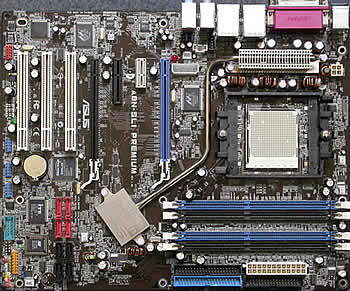
On the black PCB you'll find the various connections are colour coded, making it easier to identify where you should connect every component and cable with a quick look. You will also notice the two LED indicators, one ensures that the motherboard has properly powered up and the second informing you on the status of the SLI VGA cards, should you decide to use them.
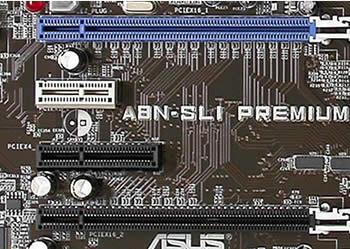
There is a lot of space between the two VGA slots. ASUS claims that this design will ensure better air circulation, cooling the cards more efficiently. You can also see the PCIx4 and the PCIx1 slots, right between the two VGA connectors, which is not the best place to be, but since there are not many PCIx1 cards available, the harm done is not so great.
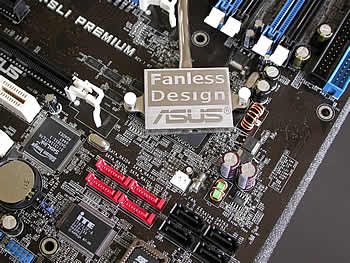
And now, ASUS presents AI Cool-Pipe technology. Completely fanless design with a nice looking heat pipe transferring all the heat away from the NVidia nForce4 MCP (Media and Communication Processor), to a small metal finned cooler, attached to a MOSFET array, very close to the CPU socket. As the liquid in the heat-pipe is heated by the MCP, it rises up to the MOSFET cooler and when it is cool enough, it returns to the MCP, cooling things down. It should be reminded that heat-pipe technology is already applied in several CPU coolers, enhancing cooling potential. Excellent idea for a noiseless motherboard.
However, we noticed strange readings from the CPU's temperature as the nForce4 MCP temperature fluctuates. It seems the heat is also transferred to the CPU or the nForce4 chipset temperature affects in some way, CPU temperature. With no CPU load, the CPU temperature and nForce4 chipset temperatures were near 38°C, while as the nForce4 temperature rose, the CPU temperature followed suit. When the nForce4 chipset temperature cooled down, so did the CPU temperature.
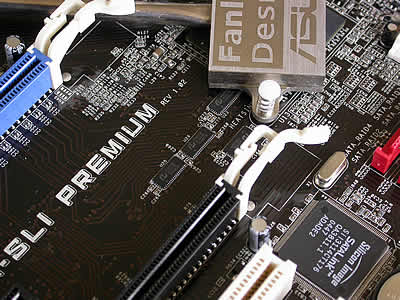
You might notice that there is no SLI PCB card selector. The small ICs (Integrated Circuits) that ASUS used with this motherboard (Pericom PCI Express compliant 2:1 mux/demux switches) can control the SLI functions (dual or single mode) from the BIOS or by using AI Selector software (included on the supplied CD).

The memory module slots are colour coded black and blue. Installing two memory modules of the same memory size on the same slot colour, enables Dual
Channel's symmetry mode.

The back panel is exactly the same as the on Deluxe version. You will find the parallel port, keyboard and mouse (PS2)
ports, audio port (digital, analog and coaxial), VGA out composite port, one IEEE1394a
port, 4 USB2.0 ports and two RJ-45 (ethernet) Jacks.
You can see below the normal IDE channel connectors and the Serial ATA connectors.


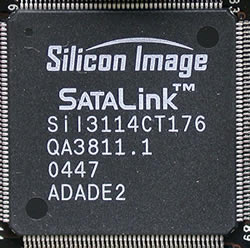
The nForce4 storage capacity, combined with the Silicon Image controller, offers support for up to 8 SATA devices. NVRAID storage (nForce4) supports RAID0, RAID1, RAID 0+1 and JBOD which can span across SATA and PATA, while the Silicon Image 3114R RAID controller offers 4 x Serial ATA with RAID0, 1, 0+1, and RAID5.
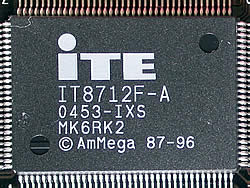
The IT8712F is the newest member of ITE
Tech's growing family of Low Pin Count Interface-based Super I/O devices
with Environment Controller integration. It provides enhanced hardware monitoring,
fan speed control, SmartGuardian control and it can also support a SmartCard
reader, has two 16C550 UARTs, one Game port, one parallel port,
floppy disk controller, keyboard controller and ITE innovative automatic
power-failure resume & power button debounce.
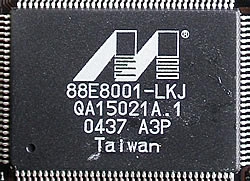
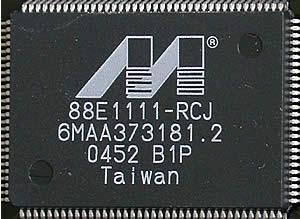
The Marvell Yukon 32-bit 88E8001 offers an additional network connectivity solution. It is Yukon's Gigabit Ethernet controller with Integrated PHY. It also provides an advanced cable diagnostics function, (Virtual Cable Tester technology) that will enable IT managers to easily pinpoint the location of cable problems.

This small Winbond chip
will give your system the ability to speak. It is a programmable speech
synthesizer that will inform you if any error occurs in the BIOS self test
scanning procedure. Users can edit and change these voices and even add their
own voice for every error that might occur.

This Realtek ALC850 is the integrated sound card packed in this small chip. This will give your system 8-channel CODEC,
Jack Sensing and Enumeration Technology and Coaxial/Optical S/PDIF out ports.
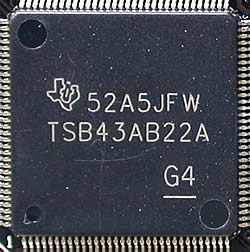
... and finally, this is the IEE1394 chipset, that offers one additional firewire port.
3. NVidia's Scalable Link Interface
 With
the appearance of the PCI Express x16 bus architecture, NVidia realized that
the main idea of using DUAL GPUs to share the load of today's high demanding
graphical environments can be applied once again, with amazing results. As
NVidia says: NVIDIA® SLI™ (Scalable Link Interface) technology
is a revolutionary approach to scalability and increased performance. NVIDIA
SLI takes advantage of the increased bandwidth of the PCI Express™ bus
architecture, and features hardware and software innovations within NVIDIA
GPUs (graphics processing units) and NVIDIA MCPs (media and communications
processors). Together the NVIDIA SLI patent-pending technologies work seamlessly
to deliver heart-pounding PC performance. And depending on the application,
NVIDIA SLI can deliver as much as 2x the performance of a single GPU configuration
for unparalleled gaming experiences.
With
the appearance of the PCI Express x16 bus architecture, NVidia realized that
the main idea of using DUAL GPUs to share the load of today's high demanding
graphical environments can be applied once again, with amazing results. As
NVidia says: NVIDIA® SLI™ (Scalable Link Interface) technology
is a revolutionary approach to scalability and increased performance. NVIDIA
SLI takes advantage of the increased bandwidth of the PCI Express™ bus
architecture, and features hardware and software innovations within NVIDIA
GPUs (graphics processing units) and NVIDIA MCPs (media and communications
processors). Together the NVIDIA SLI patent-pending technologies work seamlessly
to deliver heart-pounding PC performance. And depending on the application,
NVIDIA SLI can deliver as much as 2x the performance of a single GPU configuration
for unparalleled gaming experiences.
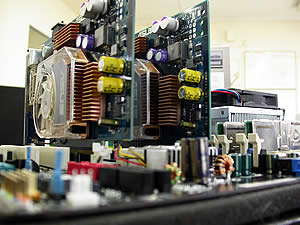

First GPU |

Second GPU |
|

Final results of Scalable Link Interface (SLI™)
|
The graphics load that the two GPUs undertake is not always the same. You can see that the graphics load in our example above, is not 50% for both GPUs. nVidia uses advanced dynamic load balancing algorithms that are responsible for sharing the load in two. This is a very clever approach, since in most games and applications, the upper part of an image might need more processing power than the lower. Having that in mind, NVidia decided to share GPU load according to GPU power needs of the game/application.
NVidia uses a digital SLI connector (3dfx's connectors were analog connectors) to connect the two cards. You will find this connector provided by ASUS in the retail package.

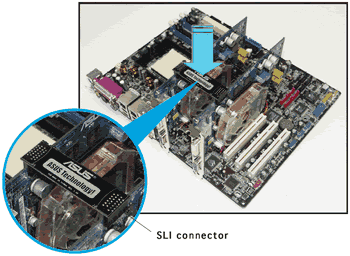
On the other hand, power requirements increase since the two GPUs need more power to function efficiently. The following table states the power requirements suggested by ASUS.
| Configuration |
Heavy Load |
Normal Load |
Light Load |
| AMD K8 939 CPU Type |
FX-55 |
3800+ |
3500+ |
| PCIe x16 Video Cards |
6800Ultra x2 |
6800GT x2 |
6600GT x2 |
| DDR DIMM Modules |
4 |
2 |
2 |
| HDD(IDE or SATA) |
4 |
2 |
2 |
| CD/DVD (IDE or SATA) |
2 |
2 |
1 |
| PCIe x1 Cards |
1 |
0 |
0 |
| PCI Cards |
3 |
2 |
1 |
| 1394 Devices |
1 |
0 |
0 |
| USB Devices |
6 |
4 |
3 |
| Required + 12V current |
> (25A) |
> (20A) |
> (17A) |
| Required wattage |
>= 500W |
>= 400W |
>= 350W |
According to NVidia, available GPUs featuring SLI support are GeForce 6800 Ultra, GeForce 6800 GT, GeForce 6800 and GeForce 6600 GT GPUs. On the other hand, ASUS released a list of certified add-in SLI VGA cards that are recommended for the A8N-SLI Deluxe. This list is shown below:
| Company |
Model Number |
| ASUS |
Extreme N6600GT |
| ASUS |
Extreme N6800Ultra (EN6800Ultra) |
| Leadtek |
WinFast PX6600GT |
| Leadtek |
WinFast PX6800GT |
| Elsa |
ELSA GLADIAC™ 660GT |
| MSI |
MS-8983 NX6600GT-VTD128E / NX6600GT-TD128E |
| Albatron |
Albatron GF6600GT |
You can always find more information about the Scalable Link Interface at the NVidia web page.
4. Test System - Configuration
- Test System
- Processor: AMD64 3800+ NewCastle (939 socket)
- Case: Antec 1080AMG
- Motherboard: ASUS A8N-SLI Premium (BIOS version: 1005)
- Memory: 2x512MB OCZ PC-4200 Memory
- Hard Disk Drive: WD800JD 80GB 7200RPM
- DVD Burner: Pioneer DVR-A08XLA
- Power Supply: EzCool 550Watt
- OS: Microsoft WindowsXP Pro SP2
- DirectX: v9.0c
Benchmarking Software
- 3DMark05,03,01
- Codecreatures Benchmark Pro v1.0
- AquaMark3 v3.0
- Farcry v1.3
- CounterStrike Source Beta
- Doom 3
- Thief 3
- Ground Control II
- Colin McRae 2005
- PCMark04
- Passmark PerformanceTest 5.0
- SiSoft Sandra Professional 2005
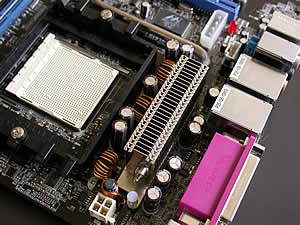
In this review, we will be comparing the ASUS A8N-SLI Premium with the two other SLI-enabled motherboards from ASUS, the A8N-SLI Deluxe and the P5ND2-SLI Deluxe. All these motherboards were tested with the same graphics cards (two ASUS N6600GT SLI) in SLI mode. The Intel based motherboard was tested with an Intel P4 3.73Ghz Extreme Edition CPU.

5. 3DMark05
 With 3DMark05, Futuremark continues the tradition in its benchmarking software by providing a state-of-the-art Microsoft ® DirectX ® 9 3D performance benchmark.
3DMark05 is an all new 3DMark version making the most of Microsoft's DirectX
9. The previous version 3DMark03 did a nice introduction into this level
of technology. However,
3DMark03 used DirectX 9 specific features in a limited manner, because fully
supporting hardware was rare at the time of its launch. In contrast, 3DMark05
requires DirectX 9 hardware with full support for at least Shader Model 2,
and takes shader usage to never before seen levels.
With 3DMark05, Futuremark continues the tradition in its benchmarking software by providing a state-of-the-art Microsoft ® DirectX ® 9 3D performance benchmark.
3DMark05 is an all new 3DMark version making the most of Microsoft's DirectX
9. The previous version 3DMark03 did a nice introduction into this level
of technology. However,
3DMark03 used DirectX 9 specific features in a limited manner, because fully
supporting hardware was rare at the time of its launch. In contrast, 3DMark05
requires DirectX 9 hardware with full support for at least Shader Model 2,
and takes shader usage to never before seen levels.
Just like its predecessors, 3DMark05's point system is set so that at the
moment of release, the high-end VGA cards available in stores can only score
around 5000 3DMarks, whereas the worst card that meets the programs requirements,
yields a score of 1000.
Game Test 1 -Return to Proxycon
 Being the sequel to the "Battle of Proxycon"
from 3DMark03, in "Return to Proxycon" we're once again set in space
and the battle continues as space pirates invade a cargo ship in order to
take control of its valuable cargo.
Being the sequel to the "Battle of Proxycon"
from 3DMark03, in "Return to Proxycon" we're once again set in space
and the battle continues as space pirates invade a cargo ship in order to
take control of its valuable cargo.
This test, tries to simulate a future first-person shooter game with all the high details that entails. The dynamic shadows, high-detailed environment and advanced lighting techniques ensure that under normal circumstances, no recent card can run it with decent frame rates.
Game Test 2 - Firefly Forest
 A forest gets filled with magic fireflies in the night. The moon is nearly full, illuminating the forest with a bluish faint light. The magic fireflies have flickering bright green lights that playfully move around the forest.
A forest gets filled with magic fireflies in the night. The moon is nearly full, illuminating the forest with a bluish faint light. The magic fireflies have flickering bright green lights that playfully move around the forest.
This scene is a nice example of a smaller scale outdoor scene with rich vegetation. Immediate visibility is not so far, and there is a skybox surrounding the whole scene.
A large number of trees with their branches swinging separately, and dense vegetation being dynamically distributed according to the camera movements, make this test the most demanding of the three.
Game Test 3 - Canyon Flight
 A Jules Verne type airship flies through a canyon guarded
by a dangerous sea monster. The airmen defend their ship using heavy cannons,
but these seem to have no effect on the huge sea monster. Finally the crew
manages a narrow escape using the "last resort" afterburners of
the airship.
A Jules Verne type airship flies through a canyon guarded
by a dangerous sea monster. The airmen defend their ship using heavy cannons,
but these seem to have no effect on the huge sea monster. Finally the crew
manages a narrow escape using the "last resort" afterburners of
the airship.
This scene is fairly complex with large areas of water
reflecting the high canyon walls. The water actually is one of the key points
of interest in this scene. The water not only does realistic looking reflections
and refractions, it has a depth fog, making the sea monster swimming under
the airship actually look deep down in the water. The air in this scene also
uses a volumetric fog, making distant cliffs of the canyon really look far
away.
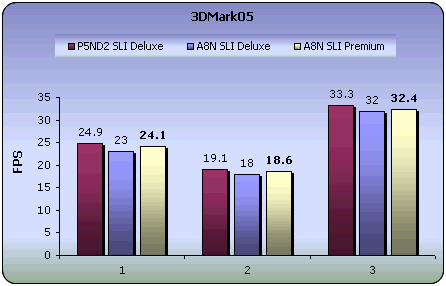
We observed only small differences in frame rates that are mostly due to the different CPUs.
Final Score
3DMarks on 3DMark05 are now calculated by the following formula:
(Game Test 1 * Game Test 2 * Game Test 3)^0.33 * 250
This is basically the geometric mean of the total frames in each
game multiplied by 250. This means that all game tests are now equal.

Better performance from the Intel based motherboard. However, the A8N-SLI Deluxe was tested with the same CPU as the Premium version and this new fanless motherboard managed to achieve more 3DMarks than the A8N-SLI Deluxe.
6. 3DMark03
 3D Mark is a widely used and accepted benchmark that stresses the DirectX performance of a VGA card. A very strong point of 3DMark is that it's VGA card measuring is does not require any CPU power. So the resulting fps are a good reference a VGA card's rendering performance. For testing the performance of each card we used the 4 game benchmarks 3DMark has.
3D Mark is a widely used and accepted benchmark that stresses the DirectX performance of a VGA card. A very strong point of 3DMark is that it's VGA card measuring is does not require any CPU power. So the resulting fps are a good reference a VGA card's rendering performance. For testing the performance of each card we used the 4 game benchmarks 3DMark has.
3Dmark03 also includes sound and CPU tests as well as some other feature tests.
- Game Test 1 - Wings of Fury (DX7)

This test is a combat flight simulator written for older hardware (DirectX 7). Particles are used a lot in this test - smoke and vapor trails, flak and gunfire, and explosions are produced using point sprites and quads.
- Game Test 2 - Battle of Proxycon (DX8)

This test is a simulation of first person shooter game types. 1.1 and 1.4 Vertex shaders are widely used since all character models are skinned using vertex shaders.This makes this test a good vertex shader comparison for VGA cards.
- Game Test 3 - Trolls' Lair (DX8)

This test should be the favorite of all RPG lovers. It is a cut scene of a female warrior facing two malicious trolls. Again the same vertex and pixel processing is used as in game test 2.
This test also uses post-processing effects, such as Depth of Field and Bloom effects which are widely used in today's game cut scene sequences.
- Game Test 4 - Mother Nature (DX9)

Mother nature represents the level of effects and realism that are possible using 2.0 vertex and pixel shaders, plus some other features that DirectX 9 offers.
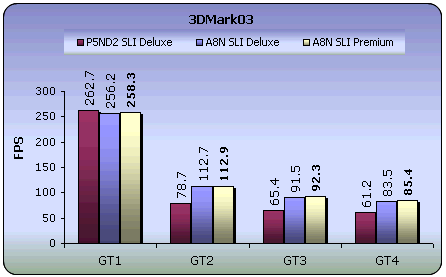
With the first game, the Intel based motherboard gave the best results. However, in comparison, the frame rates were down markedly for the other 3 games, where the A8N-SLI Premium dominated.
- 3DMark Official score
If you test your machine with 3DMark, you can post the results at 3DMark's online result browser. For more information visit futuremark.com.

As expected, the two AMD based motherboards achieved a better score than the Intel based motherboard. Additionally, the Premium version seems to be slightly improved over the "old" Deluxe version. It seems that the Pericom PCI Express compliant 2:1 mux/demux switches are doing a better job than the SLI selector did.
7. Codecreatures
 CodeCreatures is a synthetic 3D benchmark that is a good reference for VGA performance comparison. This is a high-end 3D benchmark that also requires DirectX 8 hardware, making a good tool for measuring the potential of DirectX 8 game performance.
CodeCreatures is a synthetic 3D benchmark that is a good reference for VGA performance comparison. This is a high-end 3D benchmark that also requires DirectX 8 hardware, making a good tool for measuring the potential of DirectX 8 game performance.
The Codecreatures benchmark is written with Microsoft's DirectX 8.1 API and incorporates the use of Vertex and PixelShaders popular on next generation 3D accelerators.

The benchmark plays a photo-realistic nature scene and calculates the performance of the graphics adapter by measuring the fps that it can display at 1024x768, 1280x1024 and 1600x1200 resolutions.
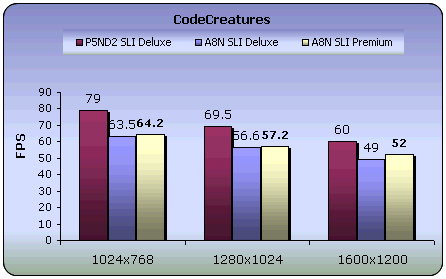
-Codecreatures number
The codecreatures number is the resulting score of the total
benchmarking process and is basically the geometric mean of the three frame
rates multiplied by 100.
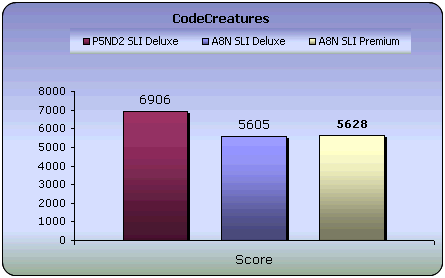
8. Aquamark/3DMark 2001
 Since the majority of today's applications and games are compatible with DirectX 9, the need of benchmark applications that use DX 9 has been brought up. The benchmark uses the 3D engine (Krass engine) of the Aquanox game.
Since the majority of today's applications and games are compatible with DirectX 9, the need of benchmark applications that use DX 9 has been brought up. The benchmark uses the 3D engine (Krass engine) of the Aquanox game.
Aquamark Triscore
The Aquamark Triscore comprises 3 values: the overall system performance, the performance of the graphics system and the CPU performance. Keep in mind that this is not the total result of the tests, but the result of the whole benchmark process including all 9 chapters.
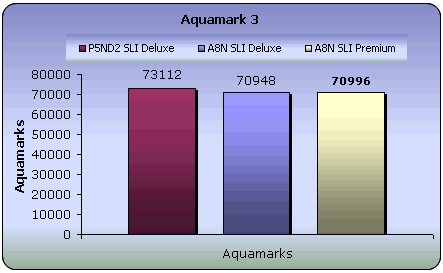
3DMark 2001
3DMark 2001 is the predecessor to 3DMark03. It's mainly a directx8.1 benchmark and the score depends a lot on the CPU power of your computer. However for reference use only we decided it'd be best to just leave it in our benchmark list so you can compare the next generation cards with the possibly outdated you have at home.
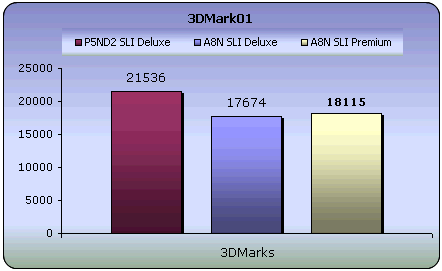
Better performance in both 3DMark01 and Aquamark 3 for the P5ND2-SLI Deluxe motherboard with the Intel CPU. Pleasantly enough, the A8N-SLI Premium version kept on giving better results than the Deluxe version.
9. Half Life 2
Half life 2 is no doubt the most anticipated pc game of all times. Gamers keeping the excellence of Half Life 1 in their mind as well as the remarkable E3 demo preview, have been anxiously waiting for the much delayed release of HL2.
 Characters - Advanced facial animation system delivers the most sophisticated in-game characters ever seen. With 40 distinct facial "muscles," human characters convey the full array of human emotion, and respond to the player with fluidity and intelligence.
Characters - Advanced facial animation system delivers the most sophisticated in-game characters ever seen. With 40 distinct facial "muscles," human characters convey the full array of human emotion, and respond to the player with fluidity and intelligence.
Physics - From pebbles to water to 2-ton trucks respond as expected, as they obey the laws of mass, friction, gravity, and buoyancy.
 Graphics
- Source's shader-based renderer, like the one used at Pixar to create movies
such as Toy Story® and Monster's, Inc.®, creates the most beautiful
and realistic environments ever seen in a video game.
Graphics
- Source's shader-based renderer, like the one used at Pixar to create movies
such as Toy Story® and Monster's, Inc.®, creates the most beautiful
and realistic environments ever seen in a video game.
AI - Neither friends nor enemies charge blindly into the fray. They can assess threats, navigate tricky terrain, and fashion weapons from whatever is at hand.
To measure performance we used the Video Stress Test(VST) that is available in the CounterStrike:Source beta available through Steam. We set all the details to the highest level and each time changed the resolution from 800x600 up to 1600x1200.

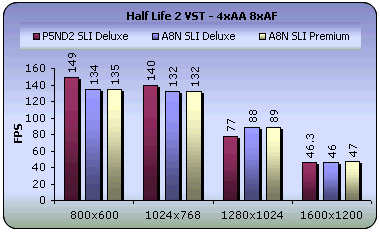
All three motherboards reported almost the same results. However, with Anti-Aliasing and Anisotropic Filtering enabled, at low resolutions, the Intel based motherboard offers slightly higher frame rates. But both the AMD based motherboards took their revenge at the higher resolutions. In any case, differences in frame rates were not significant.
10. Doom 3

A massive demonic invasion has overwhelmed the Union Aerospace Corporations? (UAC) Mars Research Facility leaving only chaos and horror in its wake. As one of the few survivors, you struggle with shock and fear as you fight your way to Hell and back, in an epic clash against pure evil.
Activision made it's miracle again with Doom 3 which is said to be the best-looking game ever, thanks to the brand-new OpenGL graphics engine used to generate its convincingly lifelike, densely atmospheric, and surprisingly expansive environments. If you are a fan of the previous Doom games then you will get many flashbacks with this revision, since you will find re-imagined versions of almost every monster from both Doom and Doom II.

To measure performance on the game we used the timedemo demo1 command from the console (Alt+Ctrl+~).
Enabling the high quality setting and executing the timedemo demo1 command twice for each resolution, we witnessed the following:
First, without the Anti-Aliasing and Anisotropic Filtering settings
enabled, we got the following results:
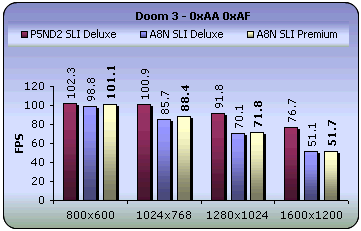
In all cases, the Intel combination seems to perform better, but you should not forget that the difference in frame rates is in the main due to the Extreme Edition CPU. In fact, with such a powerful CPU, we were expecting to see better performance. In this regard, the A8N-SLI Premium turns out to be a very powerful motherboard, more so than the P5ND2.
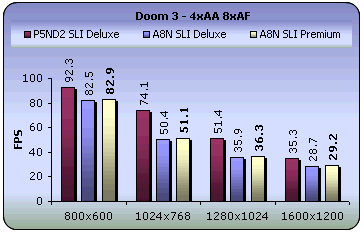
Same story here. Again the frame rates give an advantage to the Intel based system, but the differences should have been even larger. This means that the A8N-SLI Premium should perform extremely well with an equivalent CPU to the Intel Extreme Edition.
11. FarCry

 You are Jack Carver running your own boat charter business in beautiful Micronesia. With a past best left behind you, you'll be focusing on your present assignment: escorting an ambitious journalist named Valerie Cortez to the Island of Cabatu. It seems like a piece of cake, but you'll soon learn: paradise can be hell.
You are Jack Carver running your own boat charter business in beautiful Micronesia. With a past best left behind you, you'll be focusing on your present assignment: escorting an ambitious journalist named Valerie Cortez to the Island of Cabatu. It seems like a piece of cake, but you'll soon learn: paradise can be hell.
Farcry is an awesome First Person Shooter (FPS) based on a last generation 3D engine named as CryEngine. Real-time editing, bump-mapping, static lights, network system, integrated physics system, shaders, shadows and a dynamic music system are just some of the state of-the-art features that the CryEngine offers.
A great advantage and strong point of the CryEngine is its physics system which supports character inverse kinematics, vehicles, rigid bodies, liquid, rag doll, cloth and body effects. All physics seem to be very realistic and you never get bored when facing enemies, since character models have multiple animations that blend in believable ways.
With an integrated shader system and a massive terrain which maximizes
the view distance to 2km, these features make Farcry a perfect action game and
also a referable benchmark to speak of.
- Benchmark Settings
For this game we recorded a custom demo from the start of the Rebellion
stage. We chose an indoor scene in order to avoid getting the CPU-bound effect. This will result in slightly higher results since it is also less
GPU intensive, but we can't afford being stuck at 40-50 fps because of our CPU.

The latest patch (1.3) was used for our tests which updates the
game's graphics engine to use the 3.0 Shader model. This option is only supported
for the 6800 series.

The resolutions we ran the demo under are the following: 800x600,1024x768,
1280x1024 and 1600x1200.
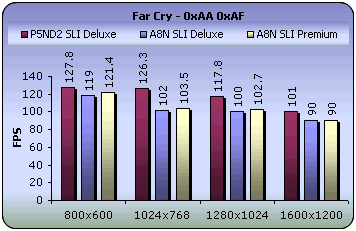

The Intel P4 3.73GHz Extreme Edition CPU sets the limit pretty high, with or without Anisotropic Filtering and Antialising enabled, but the A8N-SLI Premium manages to follow with small frame rate differences. Especially at 1600x1200 (4xAA and 8xAF), the difference is not even noticeable when playing the game.
12. Thief 3
 Instead
of Deus Ex from now on we'll be testing our cards using Thief 3. It's based
on the same engine but it's much less GPU intensive and playable by more VGA
cards than
Instead
of Deus Ex from now on we'll be testing our cards using Thief 3. It's based
on the same engine but it's much less GPU intensive and playable by more VGA
cards than  Deus.
Deus.
The game makes severe use of Pixel Shader 1.1 instructions, the bloom effect and stencil shadows to achieve a wonderful result in your screen.
In the game you play the part of Master Thief Garrett who is back to rule out any evil forces using his unique stealth abilities. Deadly Shadows shows what stealth gameplay is all about. This game really gives you the feel of sneaking around and holding your breath when stuck in a sticky situation.
Since there is no official benchmark for the game, we'll do our tests using
a GPU intensive scene from the tutorial-level which we believe that represents
the average fps you'll get when playing the game.
Thief 3 is a torture test for graphics cards. All lower class cards fail to provide stable performance in this benchmark when selecting full details from the settings menu.

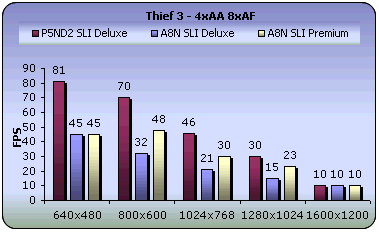
We should focus on differences between the Deluxe and the Premium versions of the A8N-SLI motherboard. In all cases, except at 1600x1200 resolution (4xAA and 8xAF), the Premium motherboard was better. Despite any differences at or below 1280x1024, at 1600x1200, all three motherboards in this comparison chart reported the same 10FPS.
13. Colin McRae 2005
 For all you racing fans out there, this test is for you and will represent the Racing game category in our benchmarks.
For all you racing fans out there, this test is for you and will represent the Racing game category in our benchmarks.
From the graphics point of view the first thing you'll
notice in the game is the excellent amount detail of your racing car. High
resolution textures on the car and lighting make it quite impressive. All
the eye candy such as the sun reflection in the virtual camera are still the
same as the older CM versions but motion blur has been added when your card
hits something hard which will happen most often if you're new to the racing
simulation world.
To measure performance on the game we used fraps to get the average fps of the whole 8th stage of UK which is actually the only stage you get to play on the demo.
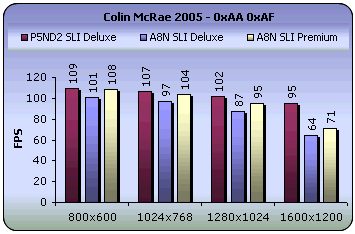
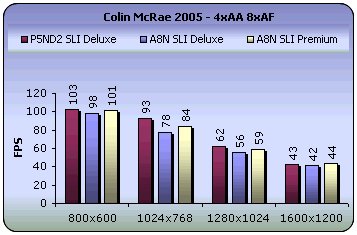
Even if the P5ND2 motherboard uses the Intel 3.73Ghz Extreme CPU, the humble AMD 3500+ with a great deal of help from the A8N-SLI Premium, approaches very closely the Intel based board performance. Despite the fact that with no Anisotropic Filtering and Anti Aliasing, the frame rate differences are greater, these are not enough to worry about.
Again, the Premium was better than the Deluxe version of the A8N-SLI motherboard.

14. Ground Control II
 Ground
Control 2 is an action-oriented game of tactics and warfare. As Captain Jacob
Angelus of the Northern Star Alliance, you will command squads of infantry,
artillery, and air power against the might of the Empire of Terra. Base building
and resource-collecting are replaced with unit control and combat tactics where
your knowledge of the battlefield maneuvers will make the difference in your
fight against a ruthless enemy. Position your troops on hilltops for better
aim or inside buildings and forests for protection as you'll need to use every
inch of terrain to your advantage.
Ground
Control 2 is an action-oriented game of tactics and warfare. As Captain Jacob
Angelus of the Northern Star Alliance, you will command squads of infantry,
artillery, and air power against the might of the Empire of Terra. Base building
and resource-collecting are replaced with unit control and combat tactics where
your knowledge of the battlefield maneuvers will make the difference in your
fight against a ruthless enemy. Position your troops on hilltops for better
aim or inside buildings and forests for protection as you'll need to use every
inch of terrain to your advantage.
For our benchmarks, we used the highest possible settings on the first mission
of the single player game and moved around the camera to get an average frame
rate using fraps.

Ground Control II offers really impressive graphics without requiring much GPU power. Click on the picture above to view a screenshot from the game. Check out these excellent water effects!
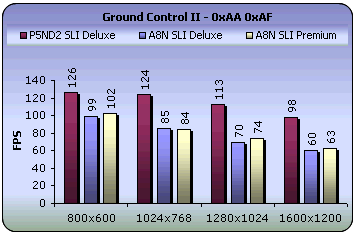
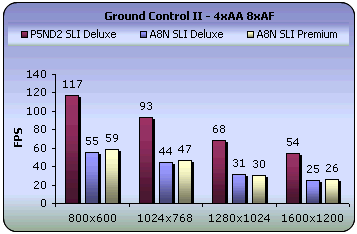
We were expecting to see a big difference between the Intel and AMD based motherboards. This test is CPU and motherboard dependent and not so much GPU. However, once again, the A8N-SLI Premium was better than its A8N-SLI Deluxe cousin.
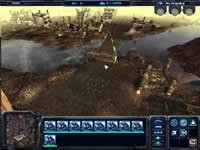
15. Performance Test v5.0
The suite of the PassMark Performance Test contains a number of suites with different tests to measure different aspects of a computer system.
The "PassMark rating" is a weighted average of all the other test results and gives a single overall indication of the computers performance. The bigger the number, the faster the computer. The "PassMark rating" can only be calculated if the results from all other tests are available. The value is calculated as follows.
| Test Suite |
Weighting |
| Disk |
20% |
| CD / DVD |
9% |
| Memory |
18% |
| 3D Graphics |
12% |
| 2D Graphics |
14% |
| CPU |
27% |
| Total |
100% |
The total score for the A8N-SLI Premium is 465.8:
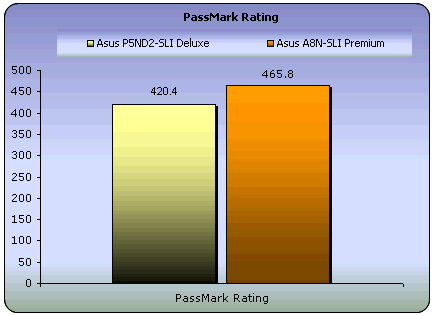

More details:

16. BIOS
Below you will find some screenshots of the Phoenix BIOS utility (version 1005).

Bios main Screen

Advanced Features tab

Onboard Device Configuration
Here, you can configure all the on-board devices of the A8N-SLI Premium. Almost the same options as with the Deluxe version.

SLI Configuration tab
Now this is something new. As mentioned before, there is no SLI Selector card, but you can now change the SLI configuration from within the BIOS. So, this is where you should go to change SLI mode.

AI Selector

No overclock profile (Manual settings)

AI Overclock Profile

AI N.O.S. Overclock Profile

VGA Overclock settings

Q-Fan2 controller and system monitor
17. Bundled Software
In the retail package, ASUS included a software CD with several useful programs that you can use to monitor or overclock your system.

This is the AI Selector software, used to change from Single VGA mode to Dual VGA mode (SLI). Unfortunately, after each change, a system restart is required. So, since you need to restart the system in any case, why not change the settings through the BIOS? ASUS thought that novice users that don't want to mess around with the BIOS can now change the SLI mode more easily.

ASUS update is a utility that helps you check your BIOS version, search the internet for an updated version and update the BIOS if required. The whole procedure is done from within Windows XP, with no need to create any boot disk or use any special updater. However, if you do know how to update the BIOS under "pure DOS", then is strongly advised for you to do so.

Cool&Quiet will monitor your CPU frequency and CPU voltage.

ASUS Probe is a monitoring utility. You might notice that the Power Fan speed monitor indicates 0 RPM. In the Deluxe version, the Power Fan monitor was replaced by the chipset Fan monitor (nForce4). However, since there is no fan on the nForce4 chip, the indicator shows 0RPM.
If you do have a PSU that uses a 3-pin connector for fan monitoring, you should not connect it to the power fan connectors, but to the chipset fan connector. ASUS mixed things up a little in this case.


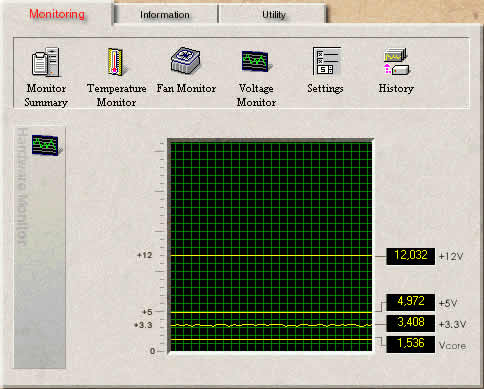
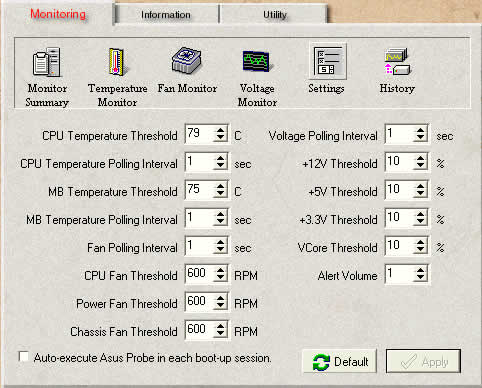
18. AIBooster - Overclocking
Below, you can see the main layout of the AIBooster software.

With AIBooster, you can actually control all the functions that the BIOS offers, through this graphical environment within the OS.

There are rumours that with BIOS versions lower than 1005, AIBooster had some problems changing the operating frequency, or even hangs when overclocked.

All the tests we did were with BIOS version 1005, and we got a stable system running at 2700.8MHz. However, we downgraded to BIOS version 1004 and we did not have any problems.
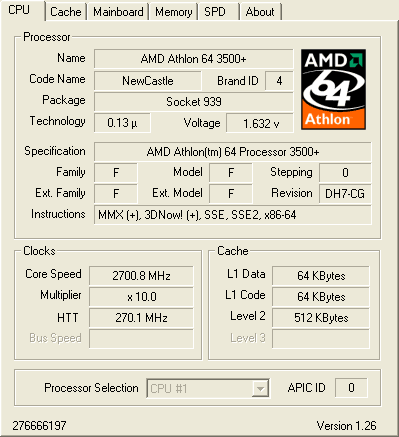
19. Conclusion
ASUS A8N-SLI Premium - Page 19
After the big success of the A8N-SLI Deluxe motherboard, ASUS decided to release a new board version, the A8N-SLI Premium. Following on the capabilities and features of the Deluxe version, the A8N-SLI Premium proved to be further improved.
The main differences between these two related boards are the AI Cool-Pipe technology and the AI Selector ICs. Completely fanless, the Premium version uses the well known heat pipe technology to transfer heat away from the nForce4 chipset, cooling things down without creating any noise.
However, with some PC cases, the motherboard is installed upside down. That is, with the PCI card backplane at the top and all the inerface connections at the bottom. This installation greatly reduces the effectiveness of the AI Cool-Pipe technology, but again, a small price to pay when you consider the reduced noise level.

With the AI Selector ICs, changing from SLI single mode to dual mode is easier than ever. No SLI selector card means you don't have to open the case to make changes inside the box. You can now change the SLI mode from within the BIOS or with the AI Selector software.

Judging from the performance charts, the ASUS A8N-SLI Premium is one of the best AMD-based motherboards available today. It even manages to outperform the A8N-SLI Deluxe. It is also is a decent overclocker, giving us almost 2700GHz with an AMD64 3500+ CPU (2200GHz standard frequency).

There is a bunch of features that ASUS offers with this board, completing the image of a very good motherboard. Unfortunately, there is no WiFi support. The ASUS A8N-SLI Premium is priced at around US$190.00.
Pros:
- Excellent features
- Noiseless operation
- Good Retail Package
- Very Good performance
- Monitor utility from within Windows
- SLI support with AI Selector
- Q-Fan2 and AI NOS features
- Great motherboard overclocking capabilities
Cons:
- No WiFi support
<- Cannot be mounted upside down as maybe the case with some cases
>
- Temperature of the nForce4 chipset affects CPU temperature
| Features |
|
| Performance |
 |
| BIOS/Overclocking |
|
Value for money |
|